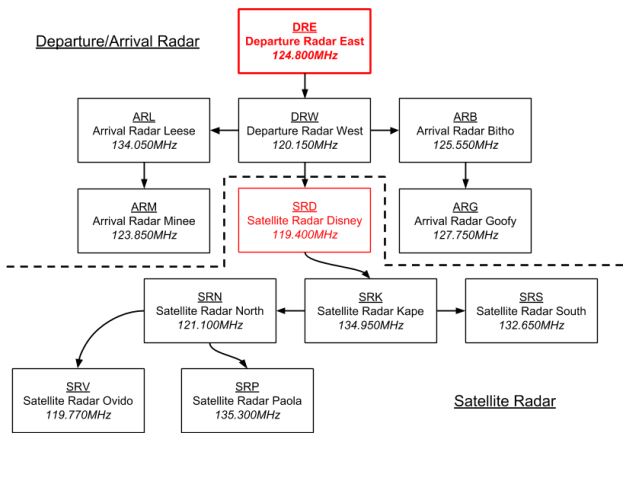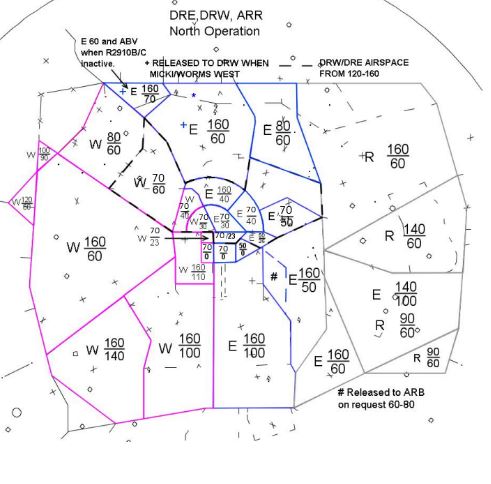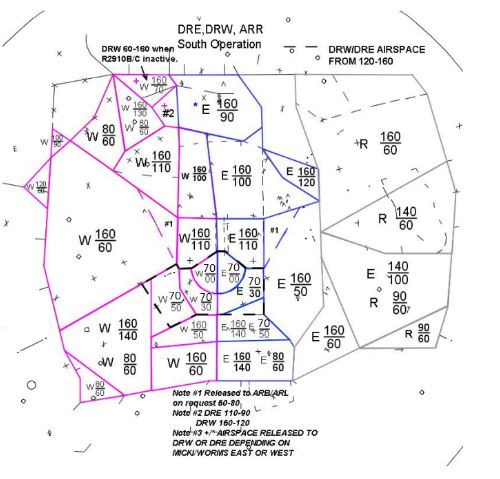F11 SOP: Difference between revisions
No edit summary |
|||
| Line 128: | Line 128: | ||
NOTE: SRP is intended to be a “final” radar position for the SFB Airport and should only be used during high-volume traffic scenarios. | NOTE: SRP is intended to be a “final” radar position for the SFB Airport and should only be used during high-volume traffic scenarios. | ||
== [[ | == [[General Information]] == | ||
< | <b>Handoffs: </b> MCO ATCT is a radar tower. Radar handoffs shall be accomplished prior to aircraft entering MCO ATCT’s area of responsibility. Any other ATCTs within F11 shall not receive a radar handoff for arriving aircraft. All other internal and external handoffs shall be initiated as soon as the aircraft are clear of conflict.<br> | ||
<br> | |||
< | <b>VFR Aircraft: </b>VFR Aircraft within the Orlando Class Bravo airspace shall ordinarily be kept below 5,000 feet and within the appropriate satellite radar position.<br> | ||
< | <br> | ||
<b>Departure Release: </b> Unless otherwise coordinated, F11 shall give automatic departure releases to all traffic from MCO. All other airports within F11 shall request a departure release for traffic receiving radar services. Upon receipt of the departure release, the release shall remain valid for five (5) consecutive minutes. Upon issuance of the takeoff clearance, a rolling call notification message shall be sent to the appropriate F11 radar controller. This notification should include the callsign of the aircraft and the departure runway the aircraft is departing from.<br> | |||
<br> | |||
<b>Rolling Calls:</b>MCO ATCT will ensure datatag auto acquires and will not send rolling calls to F11 departure controllers unless one of the following criteria is met:<br> | |||
a. The F11 departure controller requests rolling calls.<br> | |||
b. The departure scratchpads are not completed as per Chapter 7.1 of this SOP.<br> | |||
c. The departing aircraft is issued a departure heading not outlined in the MCO ATCT Standard Operating Procedures.<br> | |||
<br> | <br> | ||
< | <b>Runway Change Procedures: </b> When changing runways, LC must verbally coordinate with the appropriate F11 position(s) for the last departure/arrival off the previously used runway and the first departure/arrival off the newly selected active runway(s). Notify F11 of the new runway configuration and last departure and arrivals. When notified by F11, stop all departures on the present configuration. When F11 is ready for the new configuration, F11 will notify LC. Upon completion of notification, departures may resume with the new configuration. Ensure ATIS has been updated to reflect the new configuration.<br><br> | ||
<b>Simultaneous Approaches: <b>Runway 36L/36R and Runway 18R/18L may not be used for simultaneous instrument approaches. The ATIS shall indicate at all times “Caution simultaneous approaches in use” prior to stating the arrival runways.<br><br> | |||
== [[Departure Radar]] == | |||
<tabs> | |||
<tab name="DRE- Departure Radar East"> | |||
< | |||
<tab name=" | |||
<h3>Responsibility</h3> | <h3>Responsibility</h3> | ||
Provide approach control services within the airspace depicted<br> | |||
<h3>Departures</h3> | |||
Unless established on an RNAV SID, vector IFR departures to the appropriate DTA. | |||
<h3>Arrivals</h3> | |||
<B>TPA</b> Deliver TPA arrivals from the ALYNA ATA to DRW at 16,000 feet.<br><br> | |||
<B>TIX, TTS, XMR, COI, X21, and 21FA</b> Delivery aircraft to SRK at or descending to 6,000 feet.<br><br> | |||
<b>MLB, COF, and X59</b> Delivery jet landing MLB, COF and X59 to SRS at or descending to 6,000 feet on a vector to parallel DRE/SRS airspace. | |||
</tab> | </tab> | ||
<tab name=" | <tab name="DRW- Departure Radar West"> | ||
<h3>Responsibility</h3> | <h3>Responsibility</h3> | ||
Provide approach control services within the airspace depicted<br> | |||
<h3>Departures</h3> | |||
Unless established on an RNAV SID, vector IFR departures to the appropriate DTA. <br> | |||
When MCO is on a North Operation, do not turn MCO turbojet turbojet departures westbound prior to the ORL VORTAC. | |||
</tab> | </tab> | ||
<tab name=" | <tab name="Diagram"> | ||
<h3> | <h3>North Operations</h3> | ||
[[File:DRNORTH.JPG]] | |||
<h3>South Operations</h3> | |||
[[File:DRSOUTH.JPG]] | |||
</tab> | </tab> | ||
</tabs> | </tabs> | ||
Revision as of 11:47, 11 February 2023
Area Information
| ICAO Code | Airport Name | Airspace | IFR Beacon Codes | VFR Beacon Codes |
|---|---|---|---|---|
| F11 | Central Florida Tracon |
Purpose:
This document prescribes the procedures to be utilized for providing air traffic control services at the Central Florida Tracon. The procedures described herein are supplemental to the Jacksonville ARTCC Facility Operating Guidelines and FAA Order JO 7110.65, as well as any published FAA guidelines or procedures.
Distribution:
This order is distributed to all Jacksonville ARTCC personnel.
Operational Positions
| Position | Sector Name | Callsign | Relief Callsign | Symbol | Frequency |
|---|---|---|---|---|---|
| DRE | Departure Radar East | MCO_E_APP | MCO_1E_APP | 4E | 124.800 |
| DRW | Departure Radar West | MCO_W_APP | MCO_1W_APP | 4W | 120.150 |
| ARB | Arrival Radar Bitho | MCO_B_APP | MCO_1B_APP | 4B | 128.375 |
| ARL | Arrival Radar Leese | MCO_L_APP | MCO_1L_APP | 4L | 134.050 |
| ARG | Arrival Radar Goofy | MCO_G_APP | MCO_1G_APP | 4G | 127.750 |
| ARM | Arrival Radar Minee | MCO_M_APP | MCO_1M_APP | 4M | 123.850 |
| SRD | Satellite Radar Disney | MCO_D_APP | MCO_1D_APP | 4D | 119.400 |
| SRK | Satellite Radar Kape | MCO_K_APP | MCO_1K_APP | 4K | 134.950 |
| SRN | Satellite Radar North | MCO_N_APP | MCO_1N_APP | 4N | 121.100 |
| SRS | Satellite Radar South | MCO_S_APP | MCO_1S_APP | 4S | 132.650 |
| SRV | Satellite Radar Ovido | MCO_V_APP | MCO_4V_APP | 4V | 119.775 |
| SRP | Satellite Radar Paola | MCO_P_APP | MCO_1P_APP | 4P | 135.300 |
Sector in Red is the primary sector.
Sectorization Flow Chart
Description:
1. The primary “combined” radar position shall be DRE. No other sectors shall be staffed until the “combined” position is already in use.
2. Once DRE is in use, DRE may delegate a portion of its airspace to DRW. Thereafter, DRW may delegate a portion of its airspace to ARB.
3. Once ARB is in use, ARB may delegate a portion of its airspace to ARL. Thereafter, ARL may delegate a portion of its airspace to ARM.
4. Once ARM is in use, ARM may delegate a portion of its airspace to ARG. ARM/ARG are considered “final” radar positions and of the two ARM shall be opened first.
5. Once DRW is in use, DRW may delegate a portion of its airspace to SRD. Thereafter, SRD may delegate a portion of its airspace to SRK.
6. Once SRK is in use, SRK may delegate a portion of its airspace to SRS or SRN. Thereafter, SRN may delegate a portion of its airspace to SRV and SRP. SRV is dependent on SRN and therefore, SRV shall NOT be opened unless SRN is already in use. SRN assumes responsibility for SRV airspace when SRV is not in use.
NOTE: SRP is intended to be a “final” radar position for the SFB Airport and should only be used during high-volume traffic scenarios.
General Information
Handoffs: MCO ATCT is a radar tower. Radar handoffs shall be accomplished prior to aircraft entering MCO ATCT’s area of responsibility. Any other ATCTs within F11 shall not receive a radar handoff for arriving aircraft. All other internal and external handoffs shall be initiated as soon as the aircraft are clear of conflict.
VFR Aircraft: VFR Aircraft within the Orlando Class Bravo airspace shall ordinarily be kept below 5,000 feet and within the appropriate satellite radar position.
Departure Release: Unless otherwise coordinated, F11 shall give automatic departure releases to all traffic from MCO. All other airports within F11 shall request a departure release for traffic receiving radar services. Upon receipt of the departure release, the release shall remain valid for five (5) consecutive minutes. Upon issuance of the takeoff clearance, a rolling call notification message shall be sent to the appropriate F11 radar controller. This notification should include the callsign of the aircraft and the departure runway the aircraft is departing from.
Rolling Calls:MCO ATCT will ensure datatag auto acquires and will not send rolling calls to F11 departure controllers unless one of the following criteria is met:
a. The F11 departure controller requests rolling calls.
b. The departure scratchpads are not completed as per Chapter 7.1 of this SOP.
c. The departing aircraft is issued a departure heading not outlined in the MCO ATCT Standard Operating Procedures.
Runway Change Procedures: When changing runways, LC must verbally coordinate with the appropriate F11 position(s) for the last departure/arrival off the previously used runway and the first departure/arrival off the newly selected active runway(s). Notify F11 of the new runway configuration and last departure and arrivals. When notified by F11, stop all departures on the present configuration. When F11 is ready for the new configuration, F11 will notify LC. Upon completion of notification, departures may resume with the new configuration. Ensure ATIS has been updated to reflect the new configuration.
Simultaneous Approaches: Runway 36L/36R and Runway 18R/18L may not be used for simultaneous instrument approaches. The ATIS shall indicate at all times “Caution simultaneous approaches in use” prior to stating the arrival runways.
Departure Radar
Responsibility
Provide approach control services within the airspace depicted
Departures
Unless established on an RNAV SID, vector IFR departures to the appropriate DTA.
Arrivals
TPA Deliver TPA arrivals from the ALYNA ATA to DRW at 16,000 feet.
TIX, TTS, XMR, COI, X21, and 21FA Delivery aircraft to SRK at or descending to 6,000 feet.
MLB, COF, and X59 Delivery jet landing MLB, COF and X59 to SRS at or descending to 6,000 feet on a vector to parallel DRE/SRS airspace.
Responsibility
Provide approach control services within the airspace depicted
Departures
Unless established on an RNAV SID, vector IFR departures to the appropriate DTA.
When MCO is on a North Operation, do not turn MCO turbojet turbojet departures westbound prior to the ORL VORTAC.


